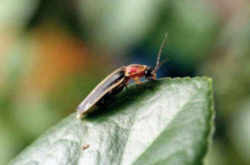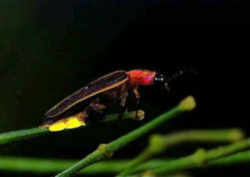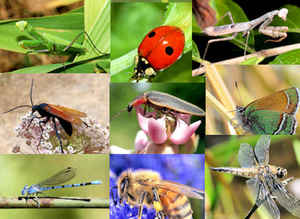
Tennessee Symbols
Tennessee State Insect (Firefly)
Firefly

(Photinus Pyralsis)
Adopted in 1975.
The firefly, (Photinus Pyralsis,) was adopted as Tennessee state insect in 1975.
Tennessee has chosen to adopt three official state insects. Two are designated "official state insects" and one is designated the "official agricultural insect." The official state insects were designated by Public Chapter 292 of the Acts of 1975. They are the well-known firefly, or lightning bug beetle, and the ladybeetle, more commonly known as the ladybug or ladybird beetle.
Tennessee State Insect: Firefly

The firefly, or lightning bug beetle, is the popular name of the luminescent insects of the Lampyridae family. In Tennessee, Photinus pyralls is the most familiar species. Their extraordinary light is generated in special organs and it is most often white, yellow, orange, greenish blue or reddish.
These interesting insects really aren't flies at all, but rather beetles from the family Lampyridae. Lampyridae is of Greek origin and is from the same root which gave us the word lamp. These luminescent beetles are the very envy of physicists around the world, because of their ability to produce "cold light". Light production in these creatures is very complex, and still not completely understood.
The firefly, or lightning bug beetle, is the popular name of the luminescent insects of the Lampyridae family. In fact, there are about 136 different species of fireflies illuminating earth's summer nights. In Tennessee, Photinus Pyralsis is the most familiar species. Their extraordinary light is generated in special organs and it is most often white, yellow, orange, greenish blue or reddish. Rather small, they are blackish, brown, yellow or reddish in color. In certain species the females remain in the larvae state and are called glowworms. Most fireflies produce short rhythmic flashes which provide a signaling system to bring the sexes together and also a protective mechanism to repel predators.
Characteristics of the Tennessee Firefly
The Firefly's Glow:
At night, the very end (the last abdominal segment) of the firefly glows a bright yellow-green color. The signal of this firefly is recognizable because it always rises upward as it flashes its bright, yellow light. This rising pattern is formed because Photinus pyralis is quite simple and is based on the time that elapses between its burst of light and the female's responses. The brightness of a single firefly is 1/40 of a candle. Males flash about every five seconds; females flash about every two seconds. The adult fireflies signal each other with their lights and mate. The female's eggs are laid a few days after mating, on or slightly under soil. The eggs hatch in 4 weeks. The larvae, once hatched, begin to feed until fall. They burrow underground and overwinter. Fireflies overwinter as larvae buried in the soil and emerge in the spring to feed. In summer, they pupate for about 2?#8218;½ weeks within a small earthen cell before emerging as adults.
The light given off by fireflies during their abdominal flashes is called bioluminescence. It happens when oxygen and the organic compound luciferin react together in the presence of the enzyme, lucifereace. This creates light. Although other insects can produce light, fireflies are the only insects that can flash their light on and off in distinct signals. Even the eggs and larvae of some firefly species glow. That's where the name "glow worm" comes from.
Anatomy:
This flying insect is about 0.75 inch (2 cm) long. It is mostly black, with two red spots on the head cover; the wing covers and head covers are lined in yellow. Like all insects, it has a hard exoskeleton, six jointed legs, two antennae, compound eyes, and a body divided into three parts (the head, thorax, and abdomen).
Diet:
Fireflies are carnivorous. They eat other insects, small animals in the soil, and snails.
Tennessee Law
The law designating the firefly as the official Tennessee state insect is found in the Tennessee Code Annotated, title 4, chapter 1, part 3, section 4-1-308a.
Title 4 State Government
Chapter 1 General Provisions
Part 3 State Symbols
Tenn. Code Ann. § 4-1-308 (2011)
4-1-308. State insects - State agricultural insect.
(a) The well-known firefly, or lightning bug beetle, and the ladybird beetle, commonly known as the ladybug, are hereby designated as the official
state insects.
(b) The honeybee is designated as the official agricultural insect of Tennessee in tribute to its fundamental role in the production of all crops.
HISTORY: Acts 1975, ch. 292, § 1; T.C.A., § 4-120; Acts 1990, ch. 725, § 1.
Taxonomic Hierarchy: Firefly
Kingdom: Animalia (Animals)
Phylum: Arthropoda (Arthropods)
Subphylum: Hexapoda (Hexapods)
Class: Insecta (Insects)
Order: Coleoptera (Beetles)
Suborder: Polyphaga (Water, Rove, Scarab, Long-horned, Leaf and Snout Beetles)
No Taxon: (Series Elateriformia)
Superfamily: Elateroidea (Click, Firefly and Soldier Beetles)
Family: Lampyridae (Fireflies)
Subfamily: Lampyrinae
Tribe; Photinini
Genus; Photinus
Species: pyralis (Photinus pyralis)
Butterflies, and Bugs







